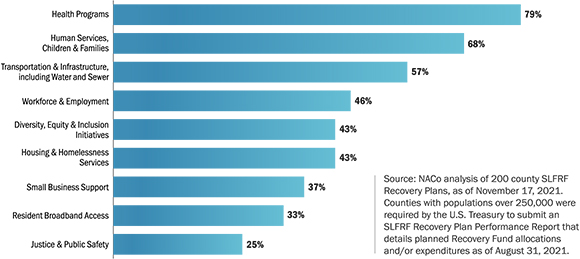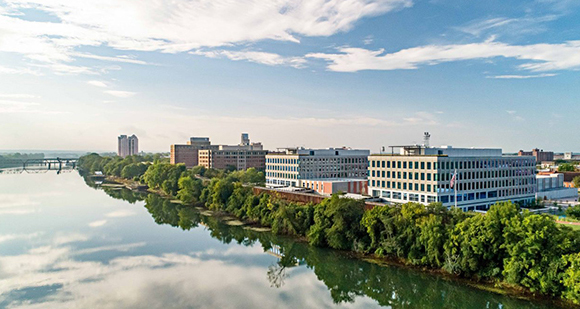|
  
|
FROM SITE
SELECTION MAGAZINE, JANUARY 2022 ISSUE
|
 |
E-COMMERCE & LOGISTICS
Using Site Selection’s Conway Projects Database, we explore how a
congested supply chain plays out in project location trends.
|
|
 |
INVESTMENT PROFILE: PFLUGERVILLE, TEXAS
The Pecan District brings major redevelopment to downtown
Pflugerville.
|
|
|
CONWAY
ANALYTICS SNAPSHOT
|

|
Looking to ferret out how federal recovery funds are being spent?
Triangulating from multiple sources is a tried and true approach.
First, there is a database maintained by the National
Association of Counties (NACo) offering data from 255 county
recovery plans (so far) detailing how they look to spend the $65.1
billion in State and Local Coronavirus Fiscal Recovery Fund monies
that went to every county in the nation (more than 3,240 of them).
The horizontal bar graph above displays results of NACo analysis of
200 of those plans.
As for the Paycheck Protection Program, all
loan data is available at the U.S. Small Business Administration
website for your viewing pleasure or consternation, as the
case may be, with figures last updated on January 3. Check your
storage space if you aim to download: The first spreadsheet of data
on loans of more than $150,000 is 427 MB in size.
Last but not least comes a new paper from the National Bureau of
Economic Research: “The $800 Billion Paycheck Protection Program:
Where Did the Money Go and Why Did It Go There?” Among its
findings about the massive spate of uncollateralized, low-interest
loans, almost all of which will be forgiven: With 93% of small
businesses ultimately receiving one or more loans, the PPP nearly
saturated its market in just two months, say the authors. “We
estimate that the program cumulatively preserved between 2 [million]
and 3 million job-years of employment over 14 months at a cost of
$170K to $257K per job-year retained,” they write. “These estimates
imply that only 23[%] to 34% of PPP dollars went directly to workers
who would otherwise have lost jobs; the balance flowed to business
owners and shareholders, including creditors and suppliers of
PPP-receiving firms. Program incidence was highly regressive, with
about three-quarters of PPP funds accruing to the top quintile of
households.”
One conclusion: “PPP’s breakneck scale-up, its high cost per job
saved, and its regressive incidence have a common origin: PPP was
essentially untargeted because the United States lacked the
administrative infrastructure to do otherwise,” they write. “The
more targeted pandemic business aid programs deployed by other
high-income countries exemplify what is feasible with better
administrative systems.” — Adam Bruns
|
|
  |

|
RESKILLING
Lumina Foundation President and CEO Jamie Merisotis and Kelly
President and CEO Peter Quigley say we’ve reached “a critical
juncture in the history of work in America.”
|
|
 |
ADVANCED MANUFACTURING
From a session at the Georgia Tech Global Business Forum in
November, we gained exclusive insights into the digitization of the
manufacturing environment from Novelis EVP and CFO Devinder Ahuja,
Novelis VP of Analytics Uma Haynes and SAS Institute’s Dan Abramson.
|
|
|
2021 GEORGIA
ECONOMIC DEVELOPMENT GUIDE
|

|
DEFENSE
Georgia cybersecurity assets secure national standing.
|
|
 |
TECHNOLOGY
Recent investments from such companies as Microsoft, Skynamo,
TeamViewer, Google, Zillow Group, GreyOrange and FanDuel Group are
growing Atlanta’s tech profile grown by leaps and bounds.
|
|
|
SITE
SELECTION RECOMMENDS
|
|
|
|
An UNCTAD study released in December looks into
the new Regional Comprehensive Economic Partnership (RCEP) that went
into effect on January 1. The Asia-Pacific trade agreement, which
includes 15 East Asian and Pacific nations of different economic
sizes and stages of development, creates a “new center of gravity”
for global trade, says UNCTAD. RCEP eliminates 90% of tariffs among
the countries in the bloc and is expected to boost intraregional
exports by $42 billion. UNCTAD’s analysis shows Japan would benefit
the most from RCEP tariff concessions. Site Selection published
analysis of RCEP by our friends at Dezan Shira & Associates seven months prior to the UNCTAD report’s
release.
|
|
New Zealand
As reported by The New Zealand Herald, Data Center Dynamics and
other sources, Australia-based DCI Data Centers has decided to build
a second data center in Auckland on a five-hectare (12.4-acre) site
where it will invest more than US$400 million in a 40-MW facility.
The company announced a 10-MW facility there in 2021. New Zealand is
in the midst of a data center boom, as hyperscale operations from
the likes of AWS, Microsoft and Canberra Data Centres move in and
develop facilities. “With increasing use of cloud services, we are
committed to a major investment program for cloud data
infrastructure in New Zealand,” said Malcolm Roe, CDI’s CEO for
Australia and New Zealand, says securing the second site is a
significant milestone in the company’s investment in New Zealand.
“These two investments by DCI will collectively bring over NZD $600
million to the Auckland region, with a combined economic value
exceeding NZD $1.4 billion over the life of the projects. Each data
center will create more than 150 jobs during construction and
approximately 250 ongoing skilled information technology and
telecommunications jobs once the sites are operational.”
Canada
EY announced earlier this week it will launch its first
Canadian-based EY Finance Center of Excellence in Calgary, beginning
with a team of 50 new hires and expanding to 200 over the next three
years. “Calgary is turning heads as a hub for talent and finance,”
said EY Canada Calgary Office Managing Partner Alison Jackson. The
company said Calgary was chosen based on its well-educated and
diverse workforce, quality of life and Alberta’s affordable cost of
living and doing business. Invest Alberta Corporation and Calgary
Economic Development collaborated to support EY with its
decision-making and planning process.
|
|

|
Photo by Andrius Aleksandravičius
courtesy of Visit Kaunas
|
|
On January 2022, Kaunas, Lithuania, officially became the European
Capital of Culture 2022. “Long before the birth of our European
Union, long before the formation of modern states, Europe was for
centuries an extraordinary network of cities,” said European Council
President Charles Michel at ceremonies in the city of 300,000,
“cities whose cultural exchanges were as rich and vibrant as their
commercial exchanges.”
Among other assets, Kaunas Free Economic Zone (FEZ), at 534 hectares
(1,320 acres) is the largest free zone in Lithuania. The city also
is known for Kaunas University of Technology (KTU), the largest
source of qualified engineers in the country. According to Invest
Lithuania, 36% of a pool of 50,000 students pursue studies in the
engineering, manufacturing and construction fields.
|
|
|
|

